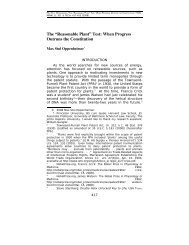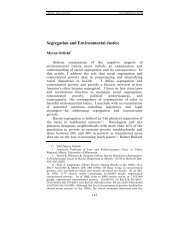An Organizational Approach to the Design of Patent Law
An Organizational Approach to the Design of Patent Law
An Organizational Approach to the Design of Patent Law
You also want an ePaper? Increase the reach of your titles
YUMPU automatically turns print PDFs into web optimized ePapers that Google loves.
6 VERTINSKY FINAL_JAD (DO NOT DELETE) 2/27/2012 2:20 PM<br />
2012] AN ORGANIZATIONAL APPROACH 253<br />
change designed <strong>to</strong> alter <strong>the</strong> ease <strong>of</strong> challenging a patent will<br />
have little effect if <strong>the</strong>re are fac<strong>to</strong>rs at <strong>the</strong> first level <strong>of</strong> analysis<br />
that constrain patent challenges, or if <strong>the</strong>re are fac<strong>to</strong>rs at <strong>the</strong><br />
third level that make enforcement prohibitively expensive. The<br />
interaction between <strong>the</strong> mechanisms and <strong>the</strong> availability <strong>of</strong><br />
multiple policy levers also suggests <strong>the</strong> need for policy coordination.<br />
For example, USPTO strategies for changing <strong>the</strong> relationship<br />
between <strong>the</strong> agency and patent applicants <strong>to</strong> encourage<br />
higher quality submissions need <strong>to</strong> be examined alongside<br />
proposed legislative changes, such as rules governing inequitable<br />
conduct. A formal rule change may have no effect on behavior<br />
if <strong>the</strong> behavior is controlled by strong norms that point in<br />
<strong>the</strong> o<strong>the</strong>r direction. Second, <strong>the</strong> relative importance <strong>of</strong> different<br />
layers for achieving desired changes in economic behavior will<br />
vary depending on <strong>the</strong> characteristics <strong>of</strong> <strong>the</strong> behavior and <strong>the</strong><br />
specific institutional context in which it takes place. Changing<br />
risk-taking behavior or beliefs about entrepreneurial ability<br />
may be most heavily influenced by efforts at cognitive change<br />
and a change in norms, whereas increasing <strong>the</strong> ability <strong>of</strong> companies<br />
<strong>to</strong> specialize may be primarily a matter <strong>of</strong> <strong>the</strong> interaction<br />
<strong>of</strong> formal rule change with governance structures. Third,<br />
<strong>the</strong> policy <strong>to</strong>ols and <strong>the</strong> opportunities for change vary significantly<br />
by level, with little scope for change at layer one and an<br />
opportunity for rapid and potentially significant change at layer<br />
five. Empirical studies are needed <strong>to</strong> determine which mechanisms<br />
predominate in different types <strong>of</strong> economic behaviors<br />
and thus, which policy variables are most likely <strong>to</strong> be effective.<br />
IV. APPLICATIONS<br />
This Part illustrates how <strong>the</strong> organizational approach<br />
works as a guide for patent law change through some examples<br />
that highlight areas in which <strong>the</strong> patent system is underperforming.<br />
A. MAKING PATENT POLICY RELEVANT TO NATIONAL<br />
INNOVATION POLICY<br />
<strong>Organizational</strong> innovation works in combination with<br />
technological innovation, and as technologies change, so do <strong>the</strong><br />
organizations which develop and use <strong>the</strong>se technologies. 186 The<br />
186. Chandler’s work on <strong>the</strong> emergence <strong>of</strong> new organizational forms points<br />
<strong>to</strong> <strong>the</strong> importance <strong>of</strong> organizational innovation working in tandem with technological<br />
innovation. See, e.g., ALFRED D. CHANDLER, STRATEGY AND






